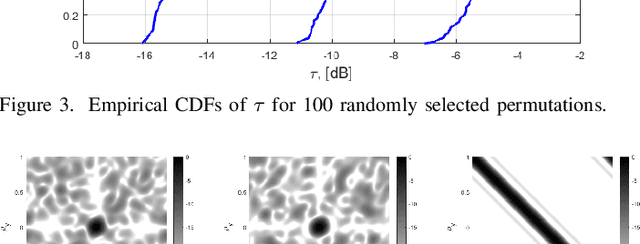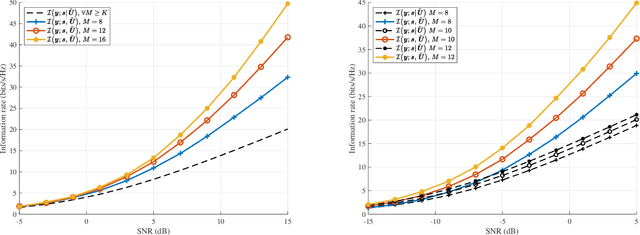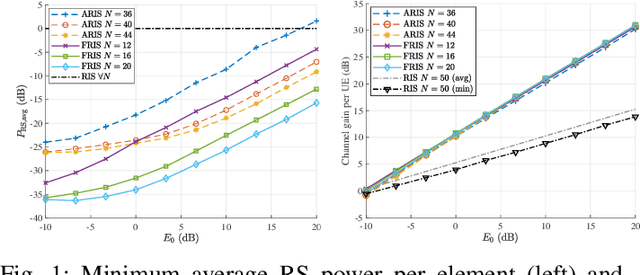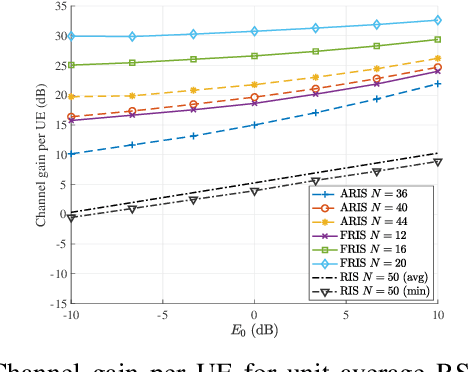Fredrik Rusek
Spatially Selective Reconfigurable Intelligent Surfaces Through Element Permutation
Mar 06, 2024



Abstract:A standard reconfigurable intelligent surface (RIS) can be configured to reflect signals from an arbitrary impinging direction to an arbitrary outgoing direction. However, if a signal impinges from any other direction, said signal is reflected, with full beamforming gain, to a specific direction, which is easily determined. The goal of this paper is to propose a RIS which \emph{only} reflects signals from the configured impinging direction. This can be accomplished by a RIS architecture that permutes the antenna elements in the sense that a signal is re-radiated from a different antenna than the one receiving the signal. We analytically prove this fact, and also discuss several variants and hardware implementations.
Towards 6G MIMO: Massive Spatial Multiplexing, Dense Arrays, and Interplay Between Electromagnetics and Processing
Jan 05, 2024Abstract:The increasing demand for wireless data transfer has been the driving force behind the widespread adoption of Massive MIMO (multiple-input multiple-output) technology in 5G. The next-generation MIMO technology is now being developed to cater to the new data traffic and performance expectations generated by new user devices and services in the next decade. The evolution towards "ultra-massive MIMO (UM-MIMO)" is not only about adding more antennas but will also uncover new propagation and hardware phenomena that can only be treated by jointly utilizing insights from the communication, electromagnetic (EM), and circuit theory areas. This article offers a comprehensive overview of the key benefits of the UM-MIMO technology and the associated challenges. It explores massive multiplexing facilitated by radiative near-field effects, characterizes the spatial degrees-of-freedom, and practical channel estimation schemes tailored for massive arrays. Moreover, we provide a tutorial on EM theory and circuit theory, and how it is used to obtain physically consistent antenna and channel models. Subsequently, the article describes different ways to implement massive and dense antenna arrays, and how to co-design antennas with signal processing. The main open research challenges are identified at the end.
Increased Multiplexing Gain with Reconfigurable Surfaces: Simultaneous Channel Orthogonalization and Information Embedding
Oct 30, 2023
Abstract:Reconfigurable surface (RS) has been shown to be an effective solution for improving wireless communication links in general multi-user multiple-input multiple-output (MU-MIMO) setting. Current research efforts have been largely directed towards the study of reconfigurable intelligent surface (RIS), which corresponds to an RS made of passive reconfigurable elements with only phase shifting capabilities. RIS constitutes a cost- and energy- efficient solution for increased beamforming gain since it allows to generate constructive interference towards desired directions, e.g., towards a base station (BS). However, in many situations, multiplexing gain may have greater impact on the achievable transmission rates and number of simultaneously connected devices, while RIS has only been able to achieve minor improvements in this aspect. Recent work has proposed the use of alternative RS technologies, namely amplitude-reconfigurable intelligent surface (ARIS) and fully-reconfigurable intelligent surface (FRIS), to achieve perfect orthogonalization of MU-MIMO channels, thus allowing for maximum multiplexing gain at reduced complexity. In this work we consider the use of ARIS and FRIS for simultaneously orthogonalizing a MU-MIMO channel, while embedding extra information in the orthogonalized channel. We show that the resulting achievable rates allow for full exploitation of the degrees of freedom in a MU-MIMO system with excess of BS antennas.
Trade-Offs in Decentralized Multi-Antenna Architectures: Sparse Combining Modules for WAX Decomposition
Sep 08, 2023Abstract:With the increase in the number of antennas at base stations (BSs), centralized multi-antenna architectures have encountered scalability problems from excessive interconnection bandwidth to the central processing unit (CPU), as well as increased processing complexity. Thus, research efforts have been directed towards finding decentralized receiver architectures where a part of the processing is performed at the antenna end (or close to it). A recent paper put forth an information-lossless trade-off between level of decentralization (inputs to CPU) and decentralized processing complexity (multiplications per antenna). This trade-off was obtained by studying a newly defined matrix decomposition--the WAX decomposition--which is directly related to the information-lossless processing that should to be applied in a general framework to exploit the trade-off. {The general framework consists of three stages: a set of decentralized filters, a linear combining module, and a processing matrix applied at the CPU; these three stages are linear transformations which can be identified with the three constituent matrices of the WAX decomposition. The previous work was unable to provide explicit constructions for linear combining modules which are valid for WAX decomposition, while it remarked the importance of these modules being sparse with 1s and 0s so they could be efficiently implemented using hardware accelerators.} In this work we present a number of constructions, as well as possible variations of them, for effectively defining linear combining modules which can be used in the WAX decomposition. Furthermore, we show how these structures facilitate decentralized calculation of the WAX decomposition for applying information-lossless processing in architectures with an arbitrary level of decentralization.
* 16 pages, 6 figures, accepted for publication at IEEE Transactions on Signal Processing
Channel Orthogonalization with Reconfigurable Surfaces
Apr 28, 2023


Abstract:Orthogonal multi-user multiple-input multiple-output (MU-MIMO) channels allow for optimum performance with simplified precoding/equalization, and they achieve maximum multiplexing gain which is shared fairly among users. Reconfigurable intelligent surface (RIS) constitutes a promising cost-efficient solution to improve the wireless channel, since they consist of passive reflecting elements able to adjust the phases of the incoming waves. However, it is still widely unclear how these surfaces can improve spatial-multiplexing. In fact, the common RIS model cannot achieve perfect orthogonalization of MU-MIMO channels with a reasonable number of elements. Furthermore, efficient channel estimation algorithms for RIS, which are key for taking advantage of its benefits, are still a matter of research. We study two types of reconfigurable surfaces (RSs), namely amplitude-reconfigurable intelligent surface (ARIS) and fully-reconfigurable intelligent surface (FRIS), with extended capabilities over RIS. We show how these RSs allow for perfect channel orthogonalization, and, by minimizing the applied power, we show that they can potentially be implemented without the need of amplification. We also present an efficient channel estimation method for each of them that allows the base station (BS) to select the desired propagation channel.
* Presented at IEEE GLOBECOM Workshops 2022
 Add to Chrome
Add to Chrome Add to Firefox
Add to Firefox Add to Edge
Add to Edge